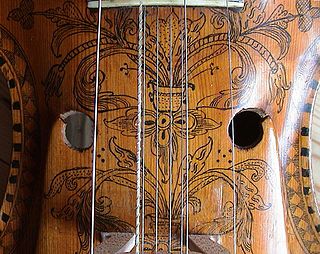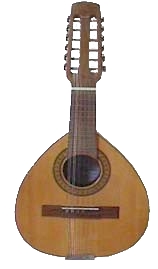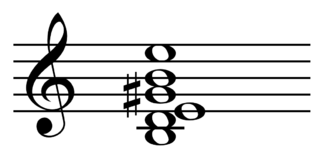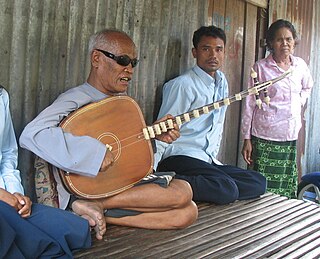
The bass guitar is a plucked string instrument similar in appearance and construction to an electric guitar, except with a longer neck and scale length, and four to six strings or courses.

String instruments, stringed instruments, or chordophones are musical instruments that produce sound from vibrating strings when the performer plays or sounds the strings in some manner.

The gayageum or kayagum is a traditional Korean zither-like string instrument with 12 strings, though some more recent variants have 21 or other numbers of strings. It is probably the best known traditional Korean musical instrument. It is related to other Asian instruments, including the Chinese guzheng, the Japanese koto, the Mongolian yatga, and the Vietnamese đàn tranh. When played, the sound varies between traditional Eurasian stringed instruments and the Appalachian banjo.
Scordatura[skordaˈtuːra], is a tuning of a stringed instrument different from the normal, standard tuning. It typically attempts to allow special effects or unusual chords or timbre, or to make certain passages easier to play. It is common to notate the finger position as if played in regular tuning, while the actual pitch resulting is altered. When all the strings are tuned by the same interval up or down, as in the case of the viola in Mozart's Sinfonia Concertante for Violin, Viola and Orchestra, the part is transposed as a whole.

The lap steel guitar is a type of steel guitar which is typically played with the instrument in a horizontal position on the performer's lap or otherwise supported. The performer changes pitch by pressing a metal or glass bar against the strings as opposed to a traditional guitar where the performer's fingertips press the strings against frets. The bar placed against the strings is called a "steel" or "tone bar".

Sympathetic strings or resonance strings are auxiliary strings found on many Indian musical instruments, as well as some Western Baroque instruments and a variety of folk instruments. They are typically not played directly by the performer, only indirectly through the tones that are played on the main strings, based on the principle of sympathetic resonance. The resonance is most often heard when the fundamental frequency of the string is in unison or an octave lower or higher than the catalyst note, although it can occur for other intervals, such as a fifth, with less effect.

The seven-string guitar adds one additional string to the more common six-string guitar, commonly used to extend the bass range or also to extend the treble range.
A tiple is a plucked-string chordophone of the guitar family. A tiple player is called a tiplista. The first mention of the tiple comes from musicologist Pablo Minguet e Irol in 1752. Although many variations of the instrument exist, the tiple is mostly associated with Colombia, and is considered the national instrument.

Guitar tunings assign pitches to the open strings of guitars, including acoustic guitars, electric guitars, and classical guitars. Tunings are described by the particular pitches denoted by notes in Western music. By convention, the notes are ordered from lowest-pitched string to highest-pitched.

The bandurria is a plucked chordophone from Spain, similar to the mandolin, primarily used in Spanish folk music, but also found in former Spanish colonies.

A course, on a stringed musical instrument, is two or more adjacent strings that are closely spaced relative to the other strings, and typically played as a single string. The strings in each course are typically tuned in unison or an octave. Course may also refer to a single string normally played on its own on an instrument with other multi-string courses, for example the bass (lowest) string on a nine-string baroque guitar.
An extended-range bass is an electric bass guitar with a wider frequency range than a standard-tuned four-string bass guitar.
In music, standard tuning refers to the typical tuning of a string instrument. This notion is contrary to that of scordatura, i.e. an alternate tuning designated to modify either the timbre or technical capabilities of the desired instrument.

E9 tuning is a common tuning for steel guitar necks of more than six strings. In particular, it is the most common tuning for the far neck on a two-neck table steel guitar or pedal steel guitar, most often combined with C6 tuning for the near neck, and also a popular tuning for single neck instruments of eight or more strings.

The cuatro is a family of Latin American string instruments found in Central and South America, Puerto Rico and other parts of the West Indies, derived from the Spanish guitar. Although some have viola-like shapes, most cuatros resemble a small to mid-sized classical guitar.

The Chapei Dong Veng or chapey (ចាប៉ី) is a Cambodian two-stringed, long-necked guitar that is usually plucked. It has two double courses of nylon strings. The top and bottom strings are typically tuned to G and C respectively, with the 12 frets having notes 1 D, 2 E, 3 F, 4 G, 5 A, 6 B, 7 C, 8 D, 9 E, 10 F, 11 G, 12 A.

The Guitarrón Chileno is a guitar-shaped plucked string instrument from Chile, with 25 or 24 (rarely) strings. Its primary contemporary use is as the instrumental accompaniment for the traditional Chilean genre of singing poetry known as Canto a lo Poeta, though a few virtuosi have also begun to develop the instrument's solo possibilities.

Viola braguesa is a stringed instrument from Braga, north-western Portugal. It has 10 strings in 5 courses. The strings are made of steel. It is tuned C4/C3–G4/G3–A4/A3–D4/D4–G4/G4. The scale length is about 500 mm (20 inches).















